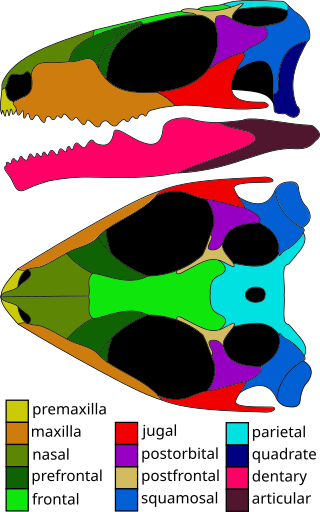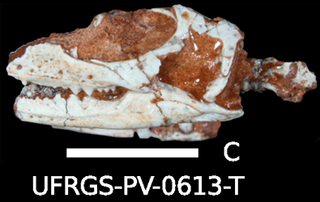
Rhynchocephalia is an order of lizard-like reptiles that includes only one living species, the tuatara of New Zealand. Despite its current lack of diversity, during the Mesozoic rhynchocephalians were a speciose group with high morphological and ecological diversity. The oldest record of the group is dated to the Middle Triassic around 238 to 240 million years ago, and they had achieved global distribution by the Early Jurassic. Most rhynchocephalians belong to the group Sphenodontia ('wedge-teeth'). Their closest living relatives are lizards and snakes in the order Squamata, with the two orders being grouped together in the superorder Lepidosauria.

Sphenodontidae is a family within the reptile group Rhynchocephalia, comprising taxa most closely related to the living tuatara. Historically the taxa included within Sphenodontidae have varied greatly between analyses, and the group has lacked a formal definition. Cynosphenodon from the Jurassic of Mexico has consistently been recovered as a close relative of the tuatara in most analyses, with the clade containing the two and other very close relatives of the tuatara often called Sphenodontinae. The herbivorous Eilenodontinae, otherwise considered part of Opisthodontia, is considered to be part of this family in many recent studies as the sister group to Sphenodontinae. The earliest Sphenodontines are known from the Early Jurassic of North America, with other remains known from the Late Jurassic of Europe, the Late Cretaceous and possibly Paleocene of South America and the Miocene-recent of New Zealand. Sphenodontines are characterised by a complete lower temporal bar caused by the fusion of a forward directed process (extension) of the quadrate/quadratojugal and the jugal, which was an adaptation for reducing stress in the skull during hard biting. Other synapomorphies of Sphenodontinae include the presence of nasal foramina, a posterodorsal process of the coronoid of the lower jaw, the present of caniniform successional teeth at the front of the jaws, the presence of flanges on the posterior parts of teeth at back of the lower jaw, and an expanded radial condyle on the humerus. Like modern tuatara, members of Sphenodontinae were likely generalists with a carnivorous/insectivorous diet.

Azendohsaurus is an extinct genus of herbivorous archosauromorph reptile from roughly the late Middle to early Late Triassic Period of Morocco and Madagascar. The type species, Azendohsaurus laaroussii, was described and named by Jean-Michel Dutuit in 1972 based on partial jaw fragments and some teeth from Morocco. A second species from Madagascar, A. madagaskarensis, was first described in 2010 by John J. Flynn and colleagues from a multitude of specimens representing almost the entire skeleton. The generic name "Azendoh lizard" is for the village of Azendoh, a local village near where it was first discovered in the Atlas Mountains. It was a bulky quadruped that unlike other early archosauromorphs had a relatively short tail and robust limbs that were held in an odd mix of sprawled hind limbs and raised forelimbs. It had a long neck and a proportionately small head with remarkably sauropod-like jaws and teeth.

Planocephalosaurus is an extinct genus of basal rhynchocephalian. Fossils of the genus are primarily known from fissure fill deposits from the Late Triassic of southwest Britain, with fragmentary remains possibly belonging to the genus also known from the Late Triassic of Texas.

Pleurosauridae is an extinct family of sphenodontian reptiles, known from the Jurassic of Europe. Members of the family had long-snake like bodies with reduced limbs that were adapted for aquatic life in marine environments. It contains two genera, Palaeopleurosaurus, which is known from the Early Jurassic (Toarcian) Posidonia Shale of Germany, as well as Pleurosaurus from the Late Jurassic of Germany and France. Paleopleurosaurus is more primitive than the later Pleurosaurus, with a skull similar to those of other sphenodontians, while that of Pleurosaurus is highly modified relative to other sphendontians. They likely swam via anguilliform locomotion. Vadasaurus and Derasmosaurus from the Late Jurassic and Early Cretaceous of Europe have been placed as part of this family in some studies, but lack the body elongation that typifies the other two genera.

Brachyrhinodon is an extinct genus of sphenodontian from the Late Triassic Lossiemouth Sandstone of Scotland.

Clevosaurus is an extinct genus of rhynchocephalian reptile from the Late Triassic and the Early Jurassic periods. Species of Clevosaurus were widespread across Pangaea, and have been found on all continents except Australia and Antarctica. Five species of Clevosaurus have been found in ancient fissure fill deposits in south-west England and Wales, alongside other sphenodontians, early mammals and dinosaurs. In regards to its Pangaean distribution, C. hadroprodon is the oldest record of a sphenodontian from Gondwana, though its affinity to Clevosaurus has been questioned.

Diphydontosaurus is an extinct genus of small rhynchocephalian reptile from the Late Triassic of Europe. It is the most primitive known member of Sphenodontia.

Gephyrosauridae is an extinct family of rhynchocephalians that lived in the Late Triassic and Early Jurassic. They are generally considered to be rhynchocephalians that lie outside of Sphenodontia, but in some analyses they are recovered as more closely related to squamates than to sphenodontians.

Sphenotitan is an extinct genus of rhynchocephalian reptile, known from the Late Triassic (Norian) Quebrada del Barro Formation of Argentina. It is the earliest known member of the herbivorous Elienodontinae, and the only one known from the Triassic. It was a large-sized sphenodontian, with an estimated skull length of over 10 centimetres (3.9 in). The skull is roughly triangular in shape, and had large upper temporal fenestrae. The region of the skull in front of the eye socket is short. The premaxillae forms beak, with a cutting edge similar to a chisel. The teeth of Sphenotitan, like other elienodontines, were large and wide, and designed for shredding vegetation, with blade-like palatal teeth on the roof of the mouth.

Atopodentatus is an extinct genus of basal sauropterygian known from the early Middle Triassic (Anisian) of Guanling Formation in Luoping County, Yunnan Province, southwestern China. It contains a single species, Atopodentatus unicus. It is thought to have lived between 247 and 240 million years ago, during the Middle Triassic period, about six million years after the Permian extinction. Atopodentatus was an herbivorous marine reptile, although marine reptiles are usually omnivores or carnivores.

Opisthodontia is a proposed clade of sphenodontian reptiles, uniting Opisthias from the Late Jurassic-earliest Cretaceous of Europe and North America with the Eilenodontinae, a group of herbivorous sphenodontians known from the Late Triassic to Late Cretaceous.

Clevosaurs are an extinct group of rhynchocephalian reptiles from the Triassic and Jurassic periods.
Fraxinisaura is an extinct genus of basal lepidosauromorph reptile known from the Middle Triassic of Germany. The only known species is Fraxinisaura rozynekae. It possessed an elongated snout, unique features of the teeth, and an ilium which was intermediate in orientation between sphenodontians and squamates. Based on characteristics of the maxilla, it is considered a close relative of Marmoretta from the Middle Jurassic of the United Kingdom, resolving a ghost lineage between that genus and other Triassic basal lepidosauromorphs.

Eilenodontinae are an extinct clade of reptiles belonging to Sphenodontia. They are either considered a subgroup of Opisthodontia, or Sphenodontidae. They had deep jaws with broad, closely packed teeth with thick enamel and noticeable wear facets. They were likely herbivorous, and probably chewed with a proal movement, with food shredded between the edges of opposing sharp-edged wear facets. Members of the group are known from South America, North America and Europe. The earliest known member of the group, Sphenotitan, is known from the Late Triassic of South America. while the youngest members are known from the Late Cretaceous of South America. The group contains some of the largest known sphenodontians, with Priosphenodon suggested to be the largest known non aquatic sphenodontian, with an estimated body length of over 1 metre (3.3 ft).
Vinitasaura is an extinct genus of lepidosauromorph from the Late Triassic of Virginia. It contains a single species, Vinitasaura lizae, which is based on a complete jaw and jaw fragment from the Carnian-age Vinita Formation of the Richmond Basin. Vinitasaura lived alongside several other lepidosauromorphs, including the sphenodontian Micromenodon and an undescribed pleurodont taxon. The Vinita Formation has the oldest lepidosauromorph assemblage found in North America, shedding light on the early diversification and dispersal of this reptile group.

Microsphenodon is an extinct genus of sphenodontian from the Late Triassic of Brazil. The type species is Microsphenodon bonapartei. It is a small sphenodontian with a skull roughly 20 mm long, and represents a unique mosaic of characteristics shared by both early diverging sphenodontians and eusphenodontian characters. Specimens of this taxon were first identified by Bonaparte and Sues (2006) but were misidentified as juvenile Clevosaurus brasiliensis, characteristics such as differences in the configuration of the teeth on the palate, and the unique form of tooth implantation seen in C. brasiliensis, helped differentiate these two co-occurring sphenodontian taxa.
Tika is an extinct genus of sphenodontian from the Late Cretaceous Candeleros Formation of Argentina. The type species is Tika giacchinoi. It is considered to be closely related to the tuatara,, and a member of the Sphenodontinae. It is the oldest member of Sphenodontinae known from South America.
Micromenodon is an extinct genus of sphenodontian from the Late Triassic Doswell Formation of Virginia. It contains a single species, Micromenodon pitti. The species is only known from a partial maxilla with teeth. It has been placed as a basal member of Sphenodontia.
Paleollanosaurus is an extinct genus of sphenodontian reptile that lived during the Late Triassic. The type species P. fraseri was described from a jaw fragment found in West Texas in North America. Remains have also been reported from Switzerland. It is generally considered a basal sphenodontian. Cladogram following Chambi-Trowell et al., 2021.














